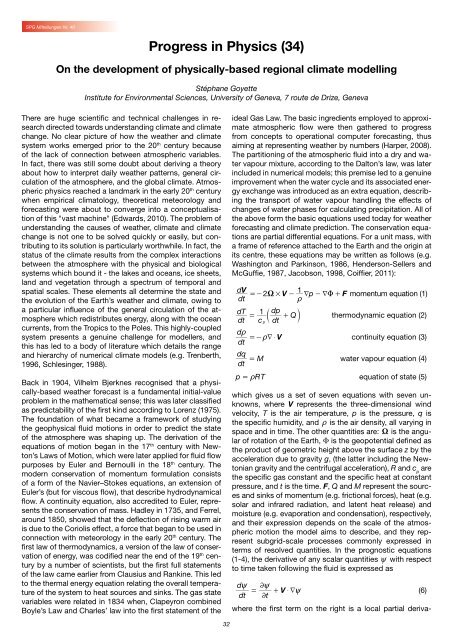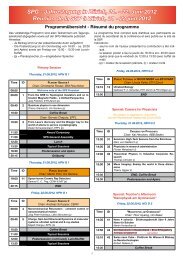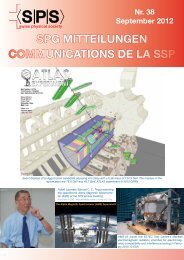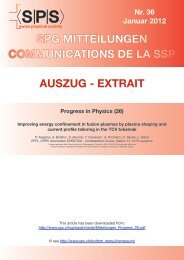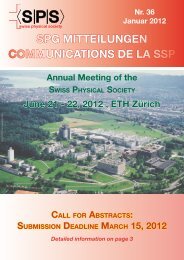spg mitteilungen communications de la ssp - Schweizerische ...
spg mitteilungen communications de la ssp - Schweizerische ...
spg mitteilungen communications de la ssp - Schweizerische ...
Create successful ePaper yourself
Turn your PDF publications into a flip-book with our unique Google optimized e-Paper software.
SPG Mitteilungen Nr. 40<br />
Progress in Physics (34)<br />
On the <strong>de</strong>velopment of physically-based regional climate mo<strong>de</strong>lling<br />
Stéphane Goyette<br />
Institute for Environmental Sciences, University of Geneva, 7 route <strong>de</strong> Drize, Geneva<br />
There are huge scientific and technical challenges in research<br />
directed towards un<strong>de</strong>rstanding climate and climate<br />
change. No clear picture of how the weather and climate<br />
system works emerged prior to the 20 th century because<br />
of the <strong>la</strong>ck of connection between atmospheric variables.<br />
In fact, there was still some doubt about <strong>de</strong>riving a theory<br />
about how to interpret daily weather patterns, general circu<strong>la</strong>tion<br />
of the atmosphere, and the global climate. Atmospheric<br />
physics reached a <strong>la</strong>ndmark in the early 20 th century<br />
when empirical climatology, theoretical meteorology and<br />
forecasting were about to converge into a conceptualisation<br />
of this "vast machine" (Edwards, 2010). The problem of<br />
un<strong>de</strong>rstanding the causes of weather, climate and climate<br />
change is not one to be solved quickly or easily, but contributing<br />
to its solution is particu<strong>la</strong>rly worthwhile. In fact, the<br />
status of the climate results from the complex interactions<br />
between the atmosphere with the physical and biological<br />
systems which bound it - the <strong>la</strong>kes and oceans, ice sheets,<br />
<strong>la</strong>nd and vegetation through a spectrum of temporal and<br />
spatial scales. These elements all <strong>de</strong>termine the state and<br />
the evolution of the Earth’s weather and climate, owing to<br />
a particu<strong>la</strong>r influence of the general circu<strong>la</strong>tion of the atmosphere<br />
which redistributes energy, along with the ocean<br />
currents, from the Tropics to the Poles. This highly-coupled<br />
system presents a genuine challenge for mo<strong>de</strong>llers, and<br />
this has led to a body of literature which <strong>de</strong>tails the range<br />
and hierarchy of numerical climate mo<strong>de</strong>ls (e.g. Trenberth,<br />
1996, Schlesinger, 1988).<br />
Back in 1904, Vilhelm Bjerknes recognised that a physically-based<br />
weather forecast is a fundamental initial-value<br />
problem in the mathematical sense; this was <strong>la</strong>ter c<strong>la</strong>ssified<br />
as predictability of the first kind according to Lorenz (1975).<br />
The foundation of what became a framework of studying<br />
the geophysical fluid motions in or<strong>de</strong>r to predict the state<br />
of the atmosphere was shaping up. The <strong>de</strong>rivation of the<br />
equations of motion began in the 17 th century with Newton’s<br />
Laws of Motion, which were <strong>la</strong>ter applied for fluid flow<br />
purposes by Euler and Bernoulli in the 18 th century. The<br />
mo<strong>de</strong>rn conservation of momentum formu<strong>la</strong>tion consists<br />
of a form of the Navier–Stokes equations, an extension of<br />
Euler’s (but for viscous flow), that <strong>de</strong>scribe hydrodynamical<br />
flow. A continuity equation, also accredited to Euler, represents<br />
the conservation of mass. Hadley in 1735, and Ferrel,<br />
around 1850, showed that the <strong>de</strong>flection of rising warm air<br />
is due to the Coriolis effect, a force that began to be used in<br />
connection with meteorology in the early 20 th century. The<br />
first <strong>la</strong>w of thermodynamics, a version of the <strong>la</strong>w of conservation<br />
of energy, was codified near the end of the 19 th century<br />
by a number of scientists, but the first full statements<br />
of the <strong>la</strong>w came earlier from C<strong>la</strong>usius and Rankine. This led<br />
to the thermal energy equation re<strong>la</strong>ting the overall temperature<br />
of the system to heat sources and sinks. The gas state<br />
variables were re<strong>la</strong>ted in 1834 when, C<strong>la</strong>peyron combined<br />
Boyle’s Law and Charles’ <strong>la</strong>w into the first statement of the<br />
i<strong>de</strong>al Gas Law. The basic ingredients employed to approximate<br />
atmospheric flow were then gathered to progress<br />
from concepts to operational computer forecasting, thus<br />
aiming at representing weather by numbers (Harper, 2008).<br />
The partitioning of the atmospheric fluid into a dry and water<br />
vapour mixture, according to the Dalton’s <strong>la</strong>w, was <strong>la</strong>ter<br />
inclu<strong>de</strong>d in numerical mo<strong>de</strong>ls; this premise led to a genuine<br />
improvement when the water cycle and its associated energy<br />
exchange was introduced as an extra equation, <strong>de</strong>scribing<br />
the transport of water vapour handling the effects of<br />
changes of water phases for calcu<strong>la</strong>ting precipitation. All of<br />
the above form the basic equations used today for weather<br />
forecasting and climate prediction. The conservation equations<br />
are partial differential equations. For a unit mass, with<br />
a frame of reference attached to the Earth and the origin at<br />
its centre, these equations may be written as follows (e.g.<br />
Washington and Parkinson, 1986, Hen<strong>de</strong>rson-Sellers and<br />
McGuffie, 1987, Jacobson, 1998, Coiffier, 2011):<br />
dV<br />
=-2X<br />
# V -<br />
1<br />
dp<br />
- dU<br />
+ F momentum equation (1)<br />
dt<br />
t<br />
dT dp<br />
=<br />
1<br />
c + Q m<br />
dt c p dt<br />
thermodynamic equation (2)<br />
dt<br />
=- td $ V<br />
dt<br />
continuity equation (3)<br />
dq<br />
dt<br />
p<br />
= M<br />
water vapour equation (4)<br />
= tRT<br />
equation of state (5)<br />
which gives us a set of seven equations with seven unknowns,<br />
where V represents the three-dimensional wind<br />
velocity, T is the air temperature, p is the pressure, q is<br />
the specific humidity, and t is the air <strong>de</strong>nsity, all varying in<br />
space and in time. The other quantities are: X is the angu<strong>la</strong>r<br />
of rotation of the Earth, is the geopotential <strong>de</strong>fined as<br />
the product of geometric height above the surface z by the<br />
acceleration due to gravity g, (the <strong>la</strong>tter including the Newtonian<br />
gravity and the centrifugal acceleration), R and c p<br />
are<br />
the specific gas constant and the specific heat at constant<br />
pressure, and t is the time. F, Q and M represent the sources<br />
and sinks of momentum (e.g. frictional forces), heat (e.g.<br />
so<strong>la</strong>r and infrared radiation, and <strong>la</strong>tent heat release) and<br />
moisture (e.g. evaporation and con<strong>de</strong>nsation), respectively,<br />
and their expression <strong>de</strong>pends on the scale of the atmospheric<br />
motion the mo<strong>de</strong>l aims to <strong>de</strong>scribe, and they represent<br />
subgrid-scale processes commonly expressed in<br />
terms of resolved quantities. In the prognostic equations<br />
(1-4), the <strong>de</strong>rivative of any sca<strong>la</strong>r quantities } with respect<br />
to time taken following the fluid is expressed as<br />
d} 2}<br />
= + V $ d}<br />
(6)<br />
dt 2t<br />
where the first term on the right is a local partial <strong>de</strong>riva-<br />
32


